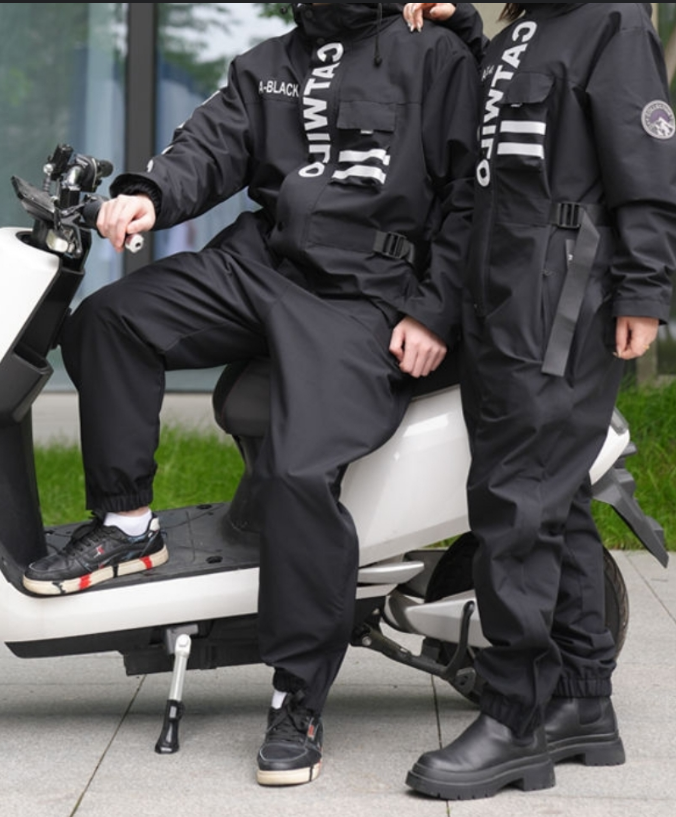Huge discounts on selected items now!
Raincoats for Men: Benefits, Types, and Choosing the Best One
9/10/20247 min read


Benefits of Raincoats for Men
Raincoats offer a myriad of advantages for men, spanning from practicality to enhanced style. Primarily, raincoats provide essential protection against rain, ensuring that the wearer remains dry and comfortable even during heavy downpours. This is particularly crucial for maintaining good health, as staying dry helps prevent colds and other weather-related illnesses. The modern designs of raincoats incorporate advanced materials that are not only waterproof but also breathable, which allows for ventilation. This ensures that men can stay dry without overheating or becoming excessively sweaty, thereby enhancing overall comfort.
Another significant benefit of raincoats is their functionality. Many contemporary raincoats come equipped with multiple pockets and additional features that enhance their utility. For example, most raincoats feature hoods, adjustable cuffs, and strategically placed vents that help in regulating temperature and providing added convenience. These design elements are especially advantageous for individuals who engage in outdoor activities or commute frequently in wet conditions, enabling them to carry essentials without compromising on dryness or comfort.
Furthermore, raincoats for men are available in a diverse range of styles and colors. This variety allows individuals to maintain a fashionable appearance regardless of the weather conditions. From classic trench coats to sporty anoraks, there is a raincoat to suit every personal style and occasion. The availability of different colors and designs ensures that men do not have to sacrifice their sense of fashion while staying protected from the rain.
In essence, raincoats merge functionality with style, offering protection and comfort while enabling men to look their best. Whether for casual wear or professional settings, the right raincoat can serve as a versatile addition to any wardrobe, ensuring preparedness for inclement weather without compromising on style.
Raincoat vs. Rain Jacket: Understanding the Difference
While the terms "raincoat" and "rain jacket" are often used interchangeably, they refer to distinct types of outerwear designed for wet weather protection. Understanding the differences between these two can help men make an informed choice based on their specific needs and activities.
A raincoat typically refers to a longer garment, providing extensive coverage and superior protection from the elements. Extending to mid-thigh or below, raincoats offer comprehensive shielding against rain, making them ideal for scenarios where one might face prolonged exposure to wet conditions. The added length not only ensures that more of your body stays dry, but also contributes to a smarter, more formal appearance, often preferred in urban settings and during commutes. Materials used in raincoats are usually heavier, lending themselves well to handling heavier downpours.
On the other hand, a rain jacket is generally shorter, usually ending at the waist or hips. This type of outerwear offers enhanced mobility and a lighter feel, which can be crucial when engaging in dynamic activities. Rain jackets are frequently favored by those involved in outdoor pursuits such as hiking, running, or cycling. Because of their shorter length, rain jackets can be less cumbersome to pack and carry, which is a significant advantage for those on the move. Furthermore, rain jackets often come with features aimed at active wear, such as ventilation systems and performance-enhancing fabrics.
The choice between a raincoat and a rain jacket ultimately hinges on one's personal preferences and the specific weather conditions one expects to encounter. For instance, if you're planning to navigate city streets during a heavy downpour, a raincoat's extended coverage might be more beneficial. Conversely, for outdoor activities in milder rain, the flexibility and convenience of a rain jacket could be more appropriate. Both garments serve crucial roles in a man's wardrobe, with individual benefits tailored to different environments and uses.
Are Raincoats Really Waterproof?
The question of whether raincoats are truly waterproof is central to understanding their functionality and selecting the right one for your needs. Modern raincoats are carefully designed using materials that offer varying levels of water resistance and waterproofing, incorporating advanced technologies aimed at enhancing their effectiveness. These technologies include sealed seams and waterproof zippers, which are essential in ensuring that no water seeps through the tiniest openings, thereby providing comprehensive protection from the rain.
However, the degree of waterproofing can differ significantly among raincoats. Some raincoats are merely water-resistant, which means they are suitable for light to moderate rain but may allow water to penetrate under heavier conditions. These water-resistant coats are often made from materials like treated nylon or polyester, which provide a barrier against moisture while maintaining a high degree of flexibility and comfort.
On the other hand, fully waterproof raincoats are designed to withstand heavy rains and prolonged exposure to wet conditions. These raincoats usually feature materials such as Gore-Tex or other advanced waterproof membranes. These fabrics are meticulously tested to ensure they can repel water entirely, making them ideal for harsh weather conditions. Despite their superior waterproof properties, fully waterproof raincoats may face challenges regarding breathability.
One critical aspect to consider when choosing a raincoat is its breathability. While the primary function of a raincoat is to keep you dry, it is equally important that the coat allows for adequate ventilation. This prevents discomfort caused by trapped heat and sweat. Many waterproof raincoats include features such as vents, mesh linings, and breathable fabrics to help regulate temperature and moisture. These innovative additions ensure that while you remain shielded from external elements, your comfort is not compromised.
When selecting a raincoat for heavy rain, the choice of material is paramount to ensure the best protection and comfort. Several materials dominate the market, each with unique properties that cater to different needs and preferences. Here, we explore the most common materials: Gore-Tex, polyurethane (PU), PVC, and nylon, evaluating their pros and cons to help you make an informed decision.
Gore-Tex
Gore-Tex is renowned for its exemplary balance of waterproofing and breathability. This fabric is a staple in high-performance rainwear, cherished for its ability to block rain while allowing sweat vapor to escape. Featuring microscopic pores, Gore-Tex prevents water entry while facilitating airflow, making it ideal for vigorous activities in heavy rain. However, the premium performance comes at a higher price point, making Gore-Tex raincoats a significant investment.
Polyurethane (PU)
Polyurethane-coated fabrics are praised for their strong waterproof capabilities. PU raincoats offer a durable and flexible solution at a more affordable price compared to Gore-Tex. Despite their waterproof efficiency, PU raincoats tend to be less breathable, potentially causing discomfort in warmer or more humid conditions. This makes PU suitable for colder climates where breathability is less of a concern.
PVC
Polyvinyl chloride (PVC) raincoats provide robust waterproofing, often found in budget-friendly options. These raincoats are highly effective at keeping water out but come with a notable downside: lack of breathability. They might cause sweat and moisture accumulation, leading to discomfort in prolonged use. PVC raincoats are best suited for situations where cost is a primary concern and breathability is secondary.
Nylon
Nylon raincoats, often treated with a durable water repellent (DWR) finish, present a lightweight and efficient option for heavy rain. The DWR treatment enhances the waterproofing of nylon, making it a reliable choice. Lightweight and easy to pack, nylon raincoats are excellent for travel and active use. However, the level of breathability can vary, and the DWR coating may wear off over time, necessitating reapplication for continued effectiveness.
In conclusion, the ideal material for a raincoat largely depends on your specific needs and environmental conditions. For high performance and breathability, Gore-Tex remains unmatched. PU and PVC offer more budget-friendly options with strong waterproofing but vary in breathability. Nylon provides a versatile and lightweight alternative, especially suitable for active or travel purposes. Assessing these factors will help you choose the best raincoat material for heavy rain and ensure you stay dry and comfortable in inclement weather.
Choosing the Right Raincoat: Key Factors to Consider
When choosing a raincoat, it's crucial to consider several factors to ensure you get the right one for your needs. Primarily, fit and comfort should be at the forefront of your decision-making process. A well-fitted raincoat should allow for ample layering underneath and ensure freedom of movement. It's advisable to try on the raincoat with the kind of clothing you typically wear beneath it to get a true sense of its comfort and fit.
Next, assess the level of waterproofing required based on the typical weather conditions you encounter. Different raincoats offer varying degrees of water resistance, from waterproof to water-repellent. If you're frequently exposed to heavy rain, look for raincoats with high waterproof ratings, sealed seams, and waterproof zippers. This will ensure that you're protected even during torrential downpours.
Functionality-enhancing features are another consideration. Adjustable hoods, drawstrings, and cuffs can significantly improve the usability of a raincoat. An adjustable hood can provide better coverage during rainy conditions, while drawstrings and cuffs can keep water from seeping in through openings. These features add to the overall functionality, making your raincoat more versatile in various weather scenarios.
The weight and packability of the raincoat are especially important for those who travel or hike frequently. Lightweight raincoats that can be easily packed into a bag or backpack are ideal for on-the-go individuals. They ensure that you are prepared for unexpected weather changes without adding unnecessary bulk or weight to your load.
Lastly, consider the price range and brand reputation. While higher-end brands might come with a heftier price tag, they often offer superior quality, durability, and innovative features. However, there are also many mid-range brands that provide excellent value for money. Researching customer reviews and ratings can offer additional insights into the reliability and performance of various raincoat brands.
By carefully evaluating fit, waterproofing, functional features, weight, and cost, you can choose a raincoat that perfectly suits your needs and lifestyle. Making an informed decision will ensure that you stay dry, comfortable, and stylish, no matter what the weather brings.
Proper maintenance is crucial to preserve the longevity and effectiveness of your raincoat, ensuring that it continues to offer optimal protection against the elements. The first and foremost step in raincoat care is regular cleaning. Dirt, oils, and other contaminants can degrade the material over time. Always refer to the manufacturer’s instructions for cleaning specific types of raincoat materials, as different materials require different care approaches.
For fabric-based raincoats, gentle hand washing with a mild detergent is often recommended. Machine washing can be risky unless explicitly stated as safe by the manufacturer. It is essential to avoid using fabric softeners or bleach, as these can break down the waterproof membrane or coatings. Rinse thoroughly to ensure that all soap residues are removed, as left-over detergent can impair the water repellency.
In addition to regular cleaning, reapplying a Durable Water Repellent (DWR) treatment can significantly enhance your raincoat's ability to resist water. The DWR coating wears off with use, and reapplication restores its water-repellent properties. DWR sprays or wash-in treatments are readily available and easy to apply. Following the product instructions carefully will yield the best results.
Proper storage of your raincoat is another critical aspect of its maintenance. Store your raincoat in a cool, dry place away from direct sunlight to prevent UV damage. Hanging the raincoat rather than folding it helps maintain its shape and prevents creases that could compromise the integrity of the waterproof materials. If the raincoat has been packed away while damp, it’s vital to air it out promptly to prevent mold and mildew growth.
Finally, promptly repairing any damage, such as small tears or worn-out areas, is essential. Most manufacturers offer repair kits or services, or you can use specialized outdoor gear repair products. Addressing damage immediately can prevent minor issues from escalating into significant problems, thereby extending the service life of your raincoat.
By adhering to these cleaning, reapplication, storage, and repair guidelines, you can ensure that your raincoat continues to provide reliable protection and remains in excellent condition for many years.
